剑桥少儿英语二级AUnit13(课堂PPT)
- 格式:ppt
- 大小:1.21 MB
- 文档页数:10
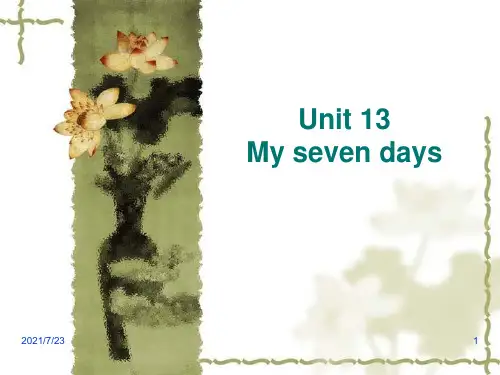
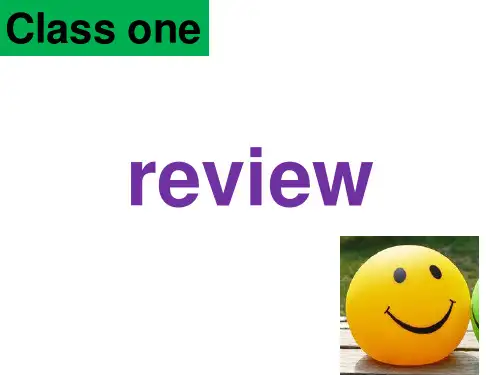
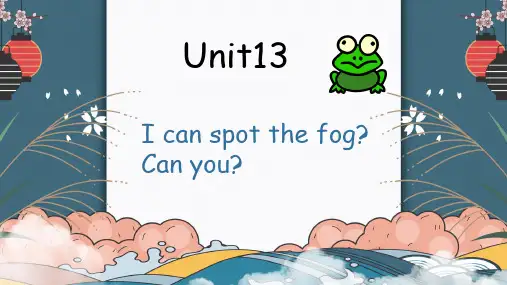
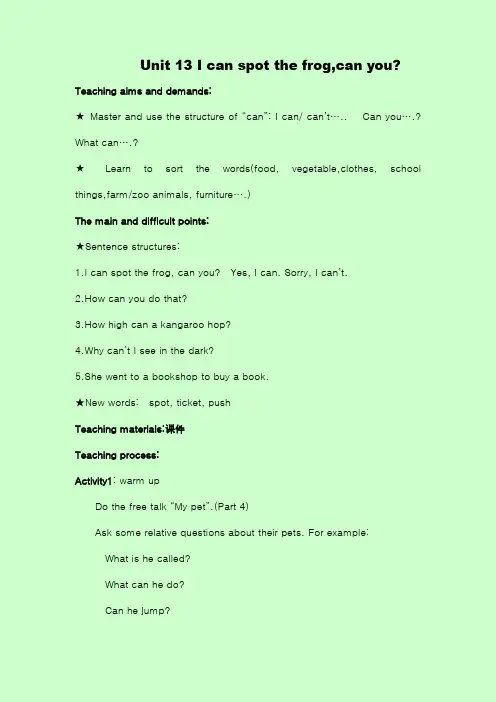
Unit 13 I can spot the frog,can you? Teaching aims and demands:★Master and use the structure of “can”: I can/ can’t….. Can you….? What can….?★Learn to sort the words(food, vegetable,clothes, school things,farm/zoo animals, furniture….)The main and difficult points:★Sentence structures:1.I can spot the frog, can you? Yes, I can. Sorry, I can’t.2.How can you do that?3.How high can a kangaroo hop?4.Why can’t I see in the dark?5.She went to a bookshop to buy a book.★New words: spot, ticket, pushTeaching materials:课件Teaching process:Activity1: warm upDo the free talk “My pet”.(Part 4)Ask some relative questions about their pets. For example: What is he called?What can he do?Can he jump?Activity 2: New lessons:※Sentence structure: Part 3, Part 5, Part 1, Part 71. Fetch out by free talk.2. Ask questions and let them answer in a competitive way.3. If they do a good job, let some of them do some actions orsome performance.4. Encourage them to ask similar questions by themselves.5. Game: Merry train6.看课件Part 1, talk about the pictures in pairs. Check somegroups.Activity3 Sentence structure : Part 21.看课件Part 1, make a story or ask some questions to lead outnew sentences: She went to a book shop to buy a book.2. 看课件, teacher says half a sentence: “ She/He went to a …”,then the students finish the sentence “ to …..”.3. Try to let the students make the similar sentences bythemselves. Then make other more sentences.4. Give them the key words and let them make sentences.For example: teacher gives key words: shop, book.Students make sentences: She went to the shop to buy a book Activity4: Listening practice: Part 9 (看课件)1. 看课件, try to talk about the pictures and then listen to the tape2. Answer teacher’s questions about the story.3. Listen to the tape again and get the key words.4. Explain the meanings. Encourage them to make somesentences.5. Open the book and read the story.Activity4: Summary看Part 1课件, ask and answer some questions. Make some sentences about it.Activity5: Homework1.Listen to the tape.2. Use the sentence structure to make sentences.课件使用说明:新知堂课件。
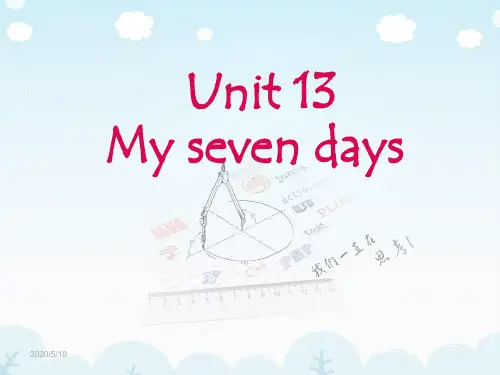
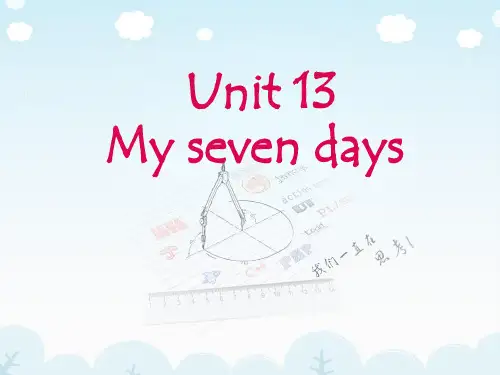
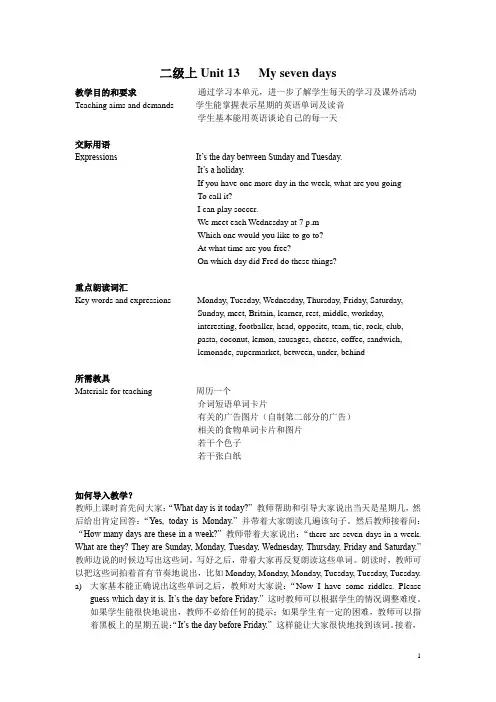
二级上Unit 13 My seven days教学目的和要求通过学习本单元,进一步了解学生每天的学习及课外活动Teaching aims and demands 学生能掌握表示星期的英语单词及读音学生基本能用英语谈论自己的每一天交际用语Expressions It’s the day between Sunday and Tuesday.It’s a holiday.If you have one more day in the week, what are you goingTo call it?I can play soccer.We meet each Wednesday at 7 p.mWhich one would you like to go to?At what time are you free?On which day did Fred do these things?重点朗读词汇Key words and expressions Monday, Tuesday, Wednesday, Thursday, Friday, Saturday,Sunday, meet, Britain, learner, rest, middle, workday,interesting, footballer, head, opposite, team, tie, rock, club,pasta, coconut, lemon, sausages, cheese, coffee, sandwich,lemonade, supermarket, between, under, behind所需教具Materials for teaching 周历一个介词短语单词卡片有关的广告图片(自制第二部分的广告)相关的食物单词卡片和图片若干个色子若干张白纸如何导入教学?教师上课时首先问大家:“What day is it today?” 教师帮助和引导大家说出当天是星期几,然后给出肯定回答:“Yes, today is Monday.” 并带着大家朗读几遍该句子。

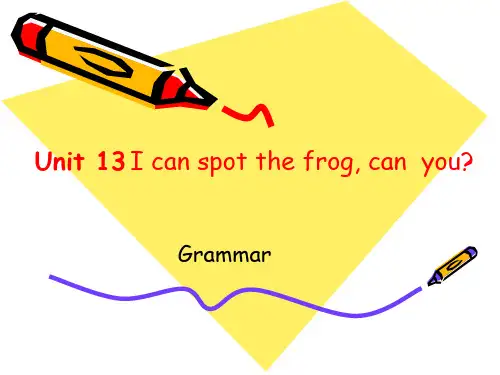

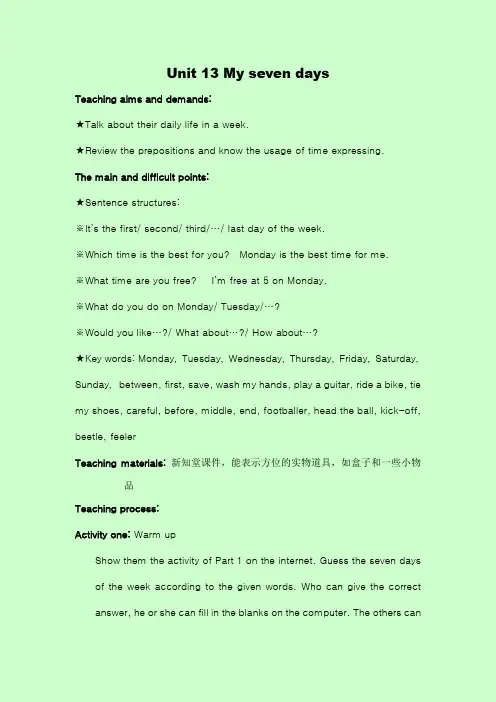
Unit 13 My seven daysTeaching aims and demands:★Talk about their daily life in a week.★Review the prepositions and know the usage of time expressing.The main and difficult points:★Sentence structures:※It’s the first/ second/ third/…/ last day of the week.※Which time is the best for you? Monday is the best time for me.※What time are you free? I’m free at 5 on Monday.※What do you do on Monday/ Tuesday/…?※Would you like…?/ What about…?/ How about…?★Key words: Monday,Tuesday,Wednesday,Thursday,Friday,Saturday,Sunday,between, first, save, wash my hands, play a guitar, ride a bike, tie my shoes, careful, before, middle, end, footballer, head the ball, kick-off, beetle, feelerTeaching materials:新知堂课件,能表示方位的实物道具,如盒子和一些小物品Teaching process:Activity one: Warm upShow them the activity of Part 1 on the internet. Guess the seven days of the week according to the given words. Who can give the correct answer, he or she can fill in the blanks on the computer. The others canhelp them to spell the words correctly.Activity two: Part 11.Review the seven days of the week together and ask some questions:what day is it today? What can you do on Mondays/ Tuesdays/ Wednesdays/…?2.Let’s listen carefully and find out what the boy often does every day?We can use different ways to go through the seven days. Before this, the teacher should explain the main and difficult words and phrases to the students. Then listen and do some exercises.For example:1)Read first, and then answer some questions from the teachers.2)Give them the questions first, then just listen without looking at theirbooks. Answer the questions after listening.3)Listen and repeat the sentences following the tape.Activity three: Chant and sing1. Watch and listen to Part 4 on the internet. Then listen and ask themsome questions about the chant.2. Listen again, point and try to repeat.3. Teacher says the first sentence of each day, the students say the next.Then have a change.4. Game: Students say the chant together, at the same time they walk ina circle. When the teacher says “stop”, they quickly sit down. The lastone should be punished: (1) Answer the questions. (2) Recite the chant. (3) Do some actions.Activity four: Part 91. Listen to the tape and get the main idea.2. Listen to the tape again and look at the sentences appeared.3. Pay attention to the main sentences and practice them fluently.First read after the tape and follow it. Then make their own sentence and conversation.4. Listen to the tape again and practice in pairs. Try to act the play. Activity five: Time to listen→Part 81.Listen to the tape and get the main idea of the passage.2.Listen again without stopping and fill in the words on their books.3.Listen for the third time and check their answers.4.Listen for the last time and repeat the passage sentence by sentence. Activity six: Preposition→Part 61.Shake the box, make some sound and ask: What’s in the box?2. Take out the things they guessed and put them in different places theylike. Then the teacher asks: “Where is it?” The students answer.3. Teacher says a sentence according to the students’ answer.For example: The teddy bear is in the box.4.Then give them some other sentences with prepositions:I watch TV in the evening.We go out for a picnic in May.I play computer games on Sundays.My birthday is on August 1st.I listen to English tapes on Saturday mornings.5.Show them the examples on the board and explain the different usage of “in, on”.6.Ask the students to make some sentences with “in, on”, check some of them.7.Give them the other two sentences:There is a big tree in front of my house.I eat my breakfast before I go to school.8.Explain it and practice it9.Read the phrases in Part 6 and make some sentences with them freely. Activity seven: Homework1. Listen to the tape of Part 8 for three times.2. Write a composition about their daily life with the knowledge they learned in this unit.课件使用说明:新知堂课件。